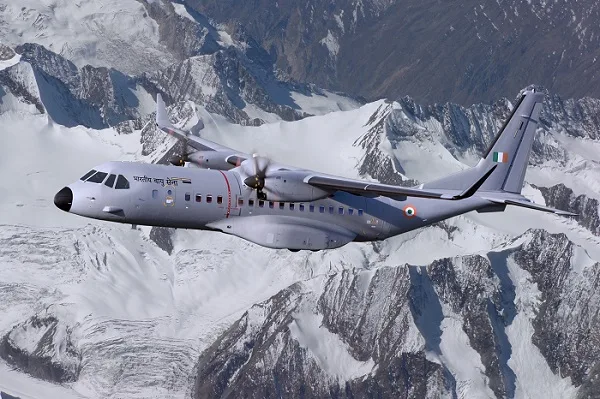India’s first C-295 aircraft has rolled out of the Airbus defence production facility in the city of Seville, located in southern Spain.
Images and videos of the military aircraft emerging from the Airbus Defence and Space’s San Pablo site, which is home to the military transport activities and the Final Assembly Line (FAL) for the four-engine turboprop-powered A400M airlifter and twin-turboprop C295, have now gone viral on social media.
The plane is the first of the 16 medium–lift tactical transport airport aircraft which will be delivered to the Indian Air Force (IAF) in flyaway condition.
Like music in our ears
– the sound of the very first engine run of an Indian #C295
. It is one out of 56 aircraft that will be delivered to @IAF_MCC. Stay tuned for the next milestone: the first test flight!
About the C295 programme in #India: https://t.co/ddA6Od6i1T pic.twitter.com/S619W72v4H— Airbus Defence (@AirbusDefence) March 2, 2023
It was in September 2021 that the Cabinet Committee on Security approved the procurement of 56 C-295MW transport aircraft from Airbus Defence following which the Ministry of Defence signed a contract for the acquisition of the aircraft with associated equipment.
The induction of the aircraft that will replace the ageing Avro aircraft of IAF has been seen as another step towards the modernisation of the country’s air force.
Roll-out of 1st #C295 for #IndianAirForce at #Airbus Defence factory in Seville, #Spain. pic.twitter.com/Re4fKK5AiR
— IDU (@defencealerts) March 1, 2023
A year later, Airbus and Tata Advanced Systems entered a collaboration for the manufacturing and assembly of the C-295 aircraft for the IAF.
Under the agreement, Tata Advanced Systems was selected as the Indian Production Agency (IPA) by Airbus. It will not only produce 40 fly-away C-295 aircraft from its facilities but will also subsequently provide MRO support and service for the total 56 aircraft that will be procured by IAF.
A contract for acquisition of 56 C-295 MW transport ac for #IAF was signed today between the Ministry of Defence (MoD) & M/s Airbus Defence and Space, Spain. Induction of the aircraft will be another step towards modernisation of the tpt fleet of IAF. pic.twitter.com/uThF3bAI43
— Indian Air Force (@IAF_MCC) September 24, 2021
In October 2022, Prime Minister Narendra Modi laid the foundation stone of the transport aircraft manufacturing project in Gujarat’s Vadodara, giving a major boost to the ‘Make in India’ initiative and domestic aviation manufacturing.
WATCH | PM @narendramodi lays the foundation stone of C-295 Aircraft manufacturing facility in Vadodara, Gujarat.
It is the first private aircraft manufacturing facility in the country.@SpokespersonMoD @IAF_MCC @Airbus pic.twitter.com/R7b4oKAI8Y
— Prasar Bharati News Services & Digital Platform (@PBNS_India) October 30, 2022
The Rs 21,935 crore project, the first of its kind in which a military aircraft will be manufactured in India by a private company, involves the full development of a complete industrial ecosystem – from the manufacture to assembly, test and qualification, to delivery and maintenance of the complete lifecycle of the aircraft.
The first 16 fly-away aircraft are scheduled to be received between September 2023 and August 2025 while the first ‘Made in India’ aircraft is expected from September 2026.
C-295MW, a transport aircraft of 5-10 tonne capacity with contemporary technology, is expected to strengthen the logistic capabilities of the IAF. It has a rear ramp door for quick reaction and para-dropping of troops and cargo. Short take-off/land from semi-prepared surfaces is another of its features. The aircraft can be used for civilian purposes as well.
Airbus Factory in Seville #AvGeek #avgeeks #aviation #planespotting #aviationdaily #aviationphotography @air_intel
A400M F-WWMS
A400M 54+35 Luftwaffe
A400M F-RBAI French AF
C295M 209 Indian AF
C295M 29501 Serbian AF
A400M A4M129 Spanish AF
A400M ZM421 RAF pic.twitter.com/6xfMlRs3tP
— Daniel Ferro (@Gibdan1) February 19, 2023
The Defence Ministry has stated that the project offers a unique opportunity for the Indian private sector to enter into the technology-intensive and highly competitive aviation industry. It will augment domestic aviation manufacturing resulting in reduced import dependence and an expected increase in exports.
Manufacturing of over 13,400 detail parts, 4,600 sub-assemblies and all the seven major component assemblies will be undertaken in India, along with tools, jigs and testers. Also, 96% of the total man-hour work per aircraft that Airbus employs at its manufacturing facility in Spain will be undertaken in India by the Tata Consortium.
Various systems such as engines, landing gear, avionics, EW suite etc, will be provided by Airbus Defence & Space and integrated into the aircraft by the Tata Consortium.
All 56 aircraft will also be fitted with the indigenous electronic warfare suite of Indian DPSUs – Bharat Electronics Ltd and Bharat Dynamics Limited.
After the completion of the delivery of 56 aircraft to IAF, Airbus will be allowed to sell the aircraft manufactured in India to civil operators and export to countries which are cleared by the Indian government.
Also Read: After fighter jets, India and Japan ready heavy-lift planes for another joint exercise





















